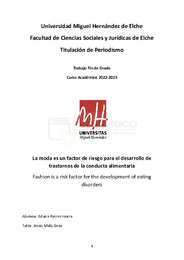Por favor, use este identificador para citar o enlazar este ítem:
https://hdl.handle.net/11000/30369Registro completo de metadatos
| Campo DC | Valor | Lengua/Idioma |
|---|---|---|
| dc.contributor.advisor | Mula Grau, Jesús | - |
| dc.contributor.author | Parres Ivorra, Aitana | - |
| dc.contributor.other | Departamentos de la UMH::Ciencias Sociales y Humanas | es_ES |
| dc.date.accessioned | 2023-12-12T11:13:33Z | - |
| dc.date.available | 2023-12-12T11:13:33Z | - |
| dc.date.created | 2023-09 | - |
| dc.identifier.uri | https://hdl.handle.net/11000/30369 | - |
| dc.description.abstract | La moda va más allá de una simple elección de prendas y estilos de vestir. Desde sus inicios se ha convertido en una forma de expresión y comunicación con el mundo exterior, donde a través de piezas de ropa buscamos la aceptación del otro. Con las nuevas tendencias de moda, que vuelven cada 30 años, muchas de las jóvenes se ven presionadas a encajar en un perfil concreto, especialmente en la figura delgada. Esto las puede llevar a crear una imagen corporal errónea y, por consecuencia, desarrollar trastornos de la conducta alimentaria (TCA). Cuando vemos una persona delgada tendemos a idealizar su cuerpo con pensamientos como que es disciplinada, exitosa y saludable. Sin embargo, consideramos gorda a una persona que se sale de lo estándar y no cabe en las tallas de ropa establecidas. La moda, junto a otros factores sociales, ha estigmatizado el sobrepeso y la obesidad, asociándose con la falta de atractivo físico y mala salud. Esto ha llevado a que los trastornos de la conducta alimentaria se hayan convertido en la enfermedad mental con mayor tasa de mortalidad, donde el 94% desarrollan esta dolencia. Es por ello que ha surgido una nueva revolución para cambiar los antiguos ideales estéticos de la sociedad, el movimiento body positive. Como respuesta a los cánones de belleza impuestos, en 1967 nació esta corriente con el objetivo de promover mensajes de amor propio y aceptación de todos los tipos de cuerpo. Ocho de cada 10 mujeres se ven mal delante del espejo, pero esta visibilización ha ayudado a no romantizar la delgadez. Con la participación de siete testimonios y varios estudios sobre la influencia de la moda en los distintos tipos de trastornos alimenticios, se aborda un problema real y muy presente en nuestra sociedad. Sobre todo, se centra en resolver las cuestiones de si la moda ha cambiado realmente o es solo un escaparate. | es_ES |
| dc.description.abstract | Fashion goes beyond a simple choice of garments and clothing styles. Since its inception, it has become a form of expression and communication with the outside world, where, through clothing, we seek acceptance of the other. With new fashion trends, which come back every 30 years, many young women are pressured to fit a particular profile, especially the slim figure. This can lead them to create an erroneous body image and, as a result, develop eating disorders (ED). When we see a thin person we tend to idealize their body with thoughts such as that they are disciplined, successful and healthy. However, we consider fat a person who is out of the standard and does not fit into the established clothing sizes. Fashion, along with other social factors, has stigmatized overweight and obesity, associating it with physical unattractiveness.This has led to eating disorders being the mental illness with the highest mortality rate, where 94% of those affected are women. This is why a new revolution has emerged to change the old aesthetic ideals of society, the body positive movement. As a response to the imposed beauty standards, this movement was born in 1966, with the aim of promoting messages of self-love and acceptance of all body types. Eight out of 10 women look bad in front of the mirror, but this visibility has helped to avoid romanticizing thinness. With the participation of seven testimonies and a study on the influence of fashion on different types of eating disorders, it addresses a real and very present problem in our society. Above all, it focuses on resolving the questions of whether fashion has really changed or is just window dressing. | es_ES |
| dc.format | application/pdf | es_ES |
| dc.format.extent | 78 | es_ES |
| dc.language.iso | spa | es_ES |
| dc.publisher | Universidad Miguel Hernández de Elche | es_ES |
| dc.rights | info:eu-repo/semantics/openAccess | es_ES |
| dc.rights | Attribution-NonCommercial-NoDerivatives 4.0 Internacional | * |
| dc.rights.uri | http://creativecommons.org/licenses/by-nc-nd/4.0/ | * |
| dc.subject | Trastornos conducta alimentaria | es_ES |
| dc.subject | enfermedad mental | es_ES |
| dc.subject | body positive | es_ES |
| dc.subject | visibilización de cuerpos | es_ES |
| dc.subject | moda | es_ES |
| dc.subject | Eating disorders | es_ES |
| dc.subject | mental illness | es_ES |
| dc.subject | body positive | es_ES |
| dc.subject | body visibilization | es_ES |
| dc.subject | fashion | es_ES |
| dc.subject.other | CDU::0 - Generalidades.::070 - Periódicos. Prensa. Periodismo. Ciencias de la información | es_ES |
| dc.title | La moda es un factor de riesgo para el desarrollo de trastornos de la conducta alimentaria | es_ES |
| dc.title.alternative | Fashion is a risk factor for the development of eating disorders | es_ES |
| dc.type | info:eu-repo/semantics/bachelorThesis | es_ES |

Ver/Abrir:
PER_TFG_ PARRES_IVORRA_AITANA.pdf
3,41 MB
Adobe PDF
Compartir:
 La licencia se describe como: Atribución-NonComercial-NoDerivada 4.0 Internacional.
La licencia se describe como: Atribución-NonComercial-NoDerivada 4.0 Internacional.
.png)